Welcome to the comprehensive care guide for the Coris Wrasse, a stunning marine fish species that will bring vibrant colors and captivating beauty to your saltwater aquarium. In this guide, I will provide you with all the information you need to ensure the optimal care and well-being of your Coris Wrasse. From their habitat and feeding requirements to their behavior and tank setup needs, we will cover it all. Let’s dive in!
Table of Contents
Key Takeaways:
- The Coris Wrasse is a visually stunning marine fish species that requires special care in a saltwater aquarium.
- They undergo a remarkable coloration transformation as they mature, transitioning from reddish-orange with white and black spots to vibrant shades of yellow, blue, and red.
- The ideal tank size for a Coris Wrasse is a minimum of 100 to 125 gallons, with larger tanks recommended for pairs or smaller versions of the fish.
- Providing a soft, sandy substrate, plenty of caves, crevices, and live rocks, and securing any heavy rocks are essential for creating a suitable tank setup.
- While the Coris Wrasse is generally considered reef-safe, caution must be exercised when adding them to a reef tank due to their potential impact on sessile invertebrates.
Species Summary of Coris Wrasse
The Coris Wrasse, also known as the Yellowtail Coris Wrasse, Clown Wrasse, or Coris gaimard, is a visually stunning marine fish species found in warm waters such as the Indo-Pacific, Fiji, the Red Sea, and the Hawaiian Islands. It undergoes a remarkable coloration transformation as it matures, transitioning from reddish-orange with white and black spots to vibrant shades of yellow, blue, and red.
With its colorful appearance and graceful movements, the Coris Wrasse is a popular choice among marine fish enthusiasts. Its striking colors add a vibrant touch to any saltwater aquarium, making it a centerpiece that captivates attention. The Coris Wrasse is known for its energetic behavior, constantly exploring its surroundings and showcasing its unique personality.
As a tropical fish, the Coris Wrasse thrives in well-maintained, species-specific saltwater aquariums. Providing the optimal habitat and meeting its specific care requirements are essential for promoting the health and longevity of this mesmerizing marine fish.
Key Highlights of the Coris Wrasse:
- Scientific Name: Coris gaimard
- Common Names: Yellowtail Coris Wrasse, Clown Wrasse
- Native Habitat: Indo-Pacific, Fiji, Red Sea, Hawaiian Islands
- Coloration: Reddish-orange with white and black spots (juveniles), vibrant shades of yellow, blue, and red (adults)
- Behavior: Energetic, inquisitive, and constantly on the move
- Size: Can grow up to 12 inches in length
- Lifespan: Typically 5 to 8 years with proper care
The Coris Wrasse’s distinct color-changing ability and captivating behavior make it a prized addition to any saltwater aquarium. In the next section, we will delve into the appearance and lifespan of this remarkable marine fish species, providing you with a deeper understanding of its unique characteristics.
Appearance and Lifespan of Coris Wrasse
The Coris Wrasse is a fascinating and visually striking marine fish species. It features a long and slender body, with males being slightly larger and more vibrantly colored than females. As juveniles, Coris Wrasses have reddish-orange bodies adorned with white and black spots, creating a captivating display of colors in the aquarium. However, as they mature, their scales undergo a remarkable transformation.
The stripes on their bodies transition from green to orange, creating a striking contrast to their vibrant fins. The fins develop shades of blue and red, while the tail becomes a vivid yellow. This transformation makes the Coris Wrasse a truly eye-catching addition to any saltwater aquarium.
The lifespan of a Coris Wrasse can range from 5 to 8 years with proper care. By providing the right environment, nutrition, and attention to their well-being, you can ensure that your Coris Wrasse thrives and adds a burst of vibrant color to your tropical fish collection.
Coris Wrasse Appearance and Lifespan
| Characteristic | Description |
|---|---|
| Body Shape | Long and slender |
| Coloration (Juvenile) | Reddish-orange with white and black spots |
| Coloration (Adult) | Stripes of green and orange body, blue and red fins, yellow tail |
| Lifespan | 5 to 8 years |
Tank Size and Water Parameters for Coris Wrasse
The Coris Wrasse is a beautiful and active marine fish that requires a suitable tank size and optimal water parameters to thrive in a saltwater aquarium. Providing the right environment is crucial for the health and well-being of the fish. Let’s explore the recommended tank size and essential water parameters for the Coris Wrasse.
Tank Size
The ideal tank size for a Coris Wrasse is a minimum of 100 to 125 gallons. This provides enough space for the fish to swim and exhibit its natural behaviors. Larger tanks are recommended for pairs or smaller versions of the Coris Wrasse, as they require more room to maneuver and establish territories. A spacious tank mimics the fish’s natural habitat and helps reduce stress.
Water Parameters
To ensure the health and well-being of the Coris Wrasse, it is crucial to maintain optimal water parameters:
- Temperature: The water temperature should be maintained between 74°F to 80°F (23°C to 27°C). This range replicates the warm tropical waters where the Coris Wrasse originates from.
- pH Levels: The pH levels should be between 8.1 to 8.4. This pH range creates a stable and suitable environment for the fish.
- Water Hardness: The water hardness should range between 8 to 12 dKH (carbonate hardness). Maintaining the appropriate hardness supports the overall health and biological processes of the Coris Wrasse.
- Specific Gravity: The specific gravity of the water should be between 1.020 to 1.025. This range ensures the proper salinity required for the fish’s osmoregulation, maintaining the balance of water and salt in its body.
By carefully monitoring and maintaining these water parameters, you can create an optimal aquatic environment for the Coris Wrasse to thrive and display its vibrant colors.
| Water Parameters | Recommended Range |
|---|---|
| Temperature | 74°F – 80°F (23°C – 27°C) |
| pH Levels | 8.1 – 8.4 |
| Water Hardness (dKH) | 8 – 12 |
| Specific Gravity | 1.020 – 1.025 |
Regularly monitoring and adjusting these water parameters will help ensure the health and longevity of your Coris Wrasse. It is also important to maintain proper filtration, perform regular water changes, and provide a well-balanced diet to keep the aquarium environment pristine and favorable for the fish.
Tank Setup for Coris Wrasse
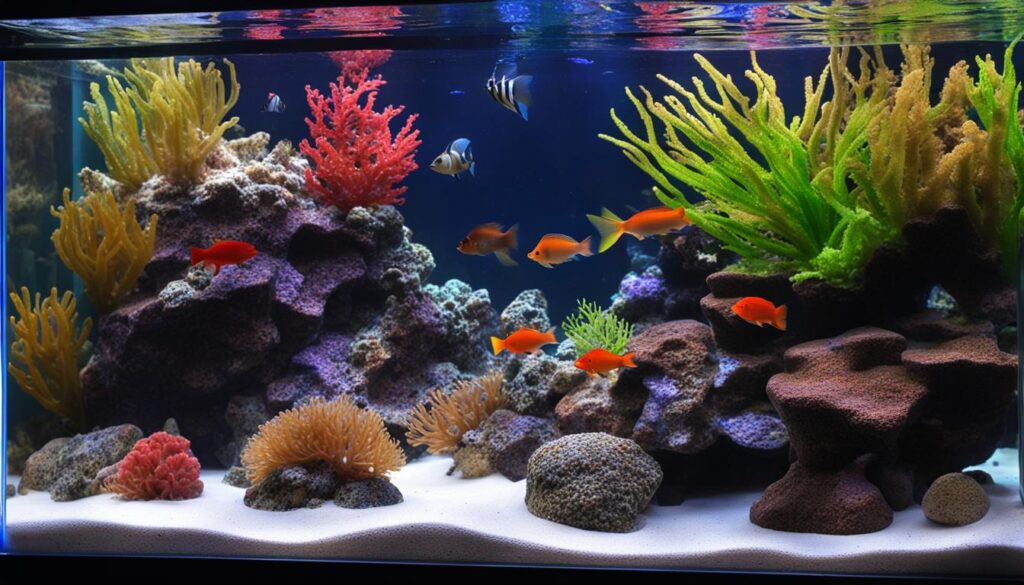
A suitable tank setup is crucial for providing a comfortable and stimulating environment for your Coris Wrasse. Here are some key considerations:
Substrate and Hiding Places
Coris Wrasses are known to burrow and seek shelter in the sandy substrate. It is recommended to have a soft, sandy substrate of at least 2 to 3 inches deep in your aquarium. This depth allows the Coris Wrasse to exhibit natural behaviors and feel secure. Additionally, providing plenty of caves, crevices, and live rocks ensures that the fish has ample hiding places to retreat to when needed. These structures mimic the fish’s natural habitat, providing enrichment and a sense of security.
Securing Rocks
When arranging the rocks in your tank, it is important to secure any heavy rocks to prevent them from toppling over and potentially harming your Coris Wrasse or damaging the tank. You can use reef-safe epoxy or aquarium-safe silicone to securely attach rocks to create stable structures in your aquarium.
Lighting, Water Changes, and Filtration
Coris Wrasses thrive in environments with bright lighting conditions, as it replicates their natural habitat. Ensure that your tank has proper lighting to promote their vibrant colors and overall health. Regular water changes are essential to maintain optimal water quality. Aim for a water change schedule of 10-20% every 2-4 weeks, depending on the size of your tank. Adequate filtration is also crucial for removing organic waste and maintaining a clean and healthy environment for your Coris Wrasse.
With a well-designed tank setup that includes the right substrate, hiding places, secure rocks, proper lighting, regular water changes, and adequate filtration, you can create an ideal habitat for your Coris Wrasse. This will allow your fish to thrive and exhibit natural behaviors, while adding a stunning touch of beauty to your saltwater aquarium.
Reef-Safety and Compatibility of Coris Wrasse
While the Coris Wrasse is generally considered reef-safe, it’s important to exercise caution when adding them to a reef tank. These colorful and vibrant marine fish may accidentally damage delicate corals while hunting for food. Additionally, they have been known to prey on sessile invertebrates such as crabs, snails, feather dusters, and shrimp.
When considering tank mates for your Coris Wrasse, it’s crucial to carefully assess compatibility to ensure a harmonious reef ecosystem. Peaceful fish species that are not likely to be seen as prey by the Coris Wrasse are good options. It’s best to avoid keeping them with small, timid fish or delicate invertebrates that may be vulnerable to their hunting behavior.
Additionally, there are certain fish species that are known to be compatible with the Coris Wrasse. Tank mates that share similar requirements in terms of water parameters, tank size, and temperament can make suitable companions. Some recommended tank mates include peaceful tangs, wrasses, gobies, and dottybacks. However, it is important to always monitor the interactions between tank mates to ensure compatibility and prevent any aggression or territorial behavior.
By carefully considering the suitability of tank mates and their potential impact on the reef ecosystem, you can create a well-balanced and thriving aquarium environment for your Coris Wrasse.
Tank Mate Compatibility Recommendations
| Tank Mate | Suitability |
|---|---|
| Peaceful Tangs | Compatible |
| Wrasses | Compatible |
| Gobies | Compatible |
| Dottybacks | Compatible |
| Small, Timid Fish | Not recommended |
| Delicate Invertebrates | Not recommended |
Remember to closely monitor the behavior and interactions between tank mates to ensure a peaceful and stress-free environment for your Coris Wrasse and other inhabitants of the aquarium.
Common Diseases and Prevention for Coris Wrasse
Like all fish, the Coris Wrasse can be susceptible to various diseases and infections. To ensure the health and well-being of your Coris Wrasse, it is crucial to maintain good water quality, regularly test the water parameters, and provide a balanced diet.
Common health issues that can affect Coris Wrasse include bacterial infections, fin rot, marine ich, and viral infections. These diseases can cause discomfort, stress, and even death if left untreated.
Prevention is key to keeping your Coris Wrasse in optimal health. Here are some preventive measures:
- Quarantine new fish: Before introducing new fish to your aquarium, it is essential to quarantine them separately for at least two to four weeks. This helps prevent the spread of any potential diseases or parasites to the existing fish in your tank.
- Proper tank maintenance: Regularly cleaning and maintaining your aquarium can go a long way in preventing the development and spread of diseases. Perform routine water changes, remove any uneaten food or waste, and keep the tank clean to minimize stress on the fish.
- Balanced diet: Providing your Coris Wrasse with a varied and nutritious diet is crucial for its overall health and immune system. Offer a mix of frozen or live foods such as brine shrimp, ghost or glass shrimp, and black worms, supplemented with high-quality pellets and flakes.
- Monitor water parameters: Regularly test the water quality using reliable test kits to ensure that the ammonia, nitrite, and nitrate levels are within the appropriate range. Maintaining stable and optimal water parameters can help prevent stress and disease in your Coris Wrasse.
By implementing these preventive measures, you can create a healthy and thriving environment for your Coris Wrasse, reducing the risk of common diseases and promoting its overall well-being.
| Common Diseases | Symptoms | Treatment |
|---|---|---|
| Bacterial Infections | Open sores, fin erosion, loss of appetite | Treat with antibiotics |
| Fin Rot | Deterioration of fins, white or red edges | Improve water quality, treat with anti-fungal medication if necessary |
| Marine Ich | White spots on the body and fins, scratching against objects | Quarantine affected fish, increase water temperature, treat with copper-based medication |
| Viral Infections | Abnormal behavior, loss of color, rapid weight loss | No specific treatment, focus on supportive care and immune system boosters |
Note: If you notice any signs of illness in your Coris Wrasse, seek the advice of a qualified marine veterinarian who can provide a proper diagnosis and recommend appropriate treatment.
Proper care and proactive disease prevention measures are essential for maintaining the health and well-being of your Coris Wrasse. By following the guidelines mentioned above, you can minimize the risk of diseases and enjoy the vibrant beauty of this incredible marine fish in your saltwater aquarium.
Feeding and Behavior of Coris Wrasse
Coris Wrasses are fascinating marine fish known for their active carnivorous nature and vibrant colors. Providing them with a well-rounded diet and creating a suitable environment that allows for their natural behaviors will promote their health and overall well-being.
Feeding Requirements of Coris Wrasses
Coris Wrasses have specific dietary needs as carnivorous predators. To ensure their optimal nutrition, a varied diet should be offered, consisting of:
- Brine shrimp
- Ghost or glass shrimp
- Black worms
- Vitamin-rich pellets and flakes
It is recommended to feed Coris Wrasses 1 to 2 times per day, allowing them to consume as much as they can within a few minutes. This feeding schedule mimics their natural feeding behaviors and helps prevent overfeeding and water quality issues.
Behavior of Coris Wrasses
Coris Wrasses are primarily diurnal, meaning they are most active during the day. Their behaviors often involve:
- Hunting: Coris Wrasses possess a strong carnivorous instinct and will actively search for food within the tank, displaying their natural predatory behavior.
- Burrowing: These fish are known to create burrows in the sandy substrate, providing them with hiding spots and security.
- Scavenging: Coris Wrasses are opportunistic feeders and will scavenge the tank for food remnants, picking up any morsels they find.
While generally shy and nervous, Coris Wrasses can thrive in a peaceful aquarium environment. They usually get along well with other non-aggressive tank mates, but caution should be exercised when introducing them to territories already occupied by compatible species.
Creating an aquarium layout that incorporates their natural behaviors, such as providing open swimming spaces, caves, and crevices for hiding, enhances the overall welfare and quality of life for Coris Wrasses.
| Feeding: | Behavior: |
|---|---|
| Coris Wrasses require a varied diet of brine shrimp, ghost or glass shrimp, black worms, and vitamin-rich pellets and flakes. | Coris Wrasses are active during the day, exhibiting hunting, burrowing, and scavenging behaviors. |
| Feeding 1-2 times per day, allowing them to eat within a few minutes. | They can be shy and nervous but generally get along well with peaceful tank mates. |
Conclusion
In conclusion, the Coris Wrasse is a visually stunning and captivating marine fish species that requires special care in a saltwater aquarium. With its vibrant colors and graceful movements, the Coris Wrasse, also known as the Yellowtail Coris Wrasse, is sure to be a beautiful addition to any tropical fish enthusiast’s collection.
Providing the appropriate tank size, water parameters, and tank setup is essential for the health and well-being of the Coris Wrasse. A minimum tank size of 100 to 125 gallons with a soft, sandy substrate and ample hiding spots will create a comfortable habitat for this colorful fish.
When it comes to feeding, the Coris Wrasse is an active carnivore that thrives on a diet consisting of brine shrimp, ghost or glass shrimp, black worms, and high-quality pellets and flakes. Regular feeding of 1 to 2 times per day will ensure its nutritional needs are met.
While the Coris Wrasse is generally compatible with peaceful tank mates, caution should be exercised when adding them to a reef tank. Their hunting instincts may inadvertently harm corals and other sessile invertebrates. Therefore, it’s important to consider their compatibility with other reef inhabitants.
In summary, the Coris Wrasse is a remarkable fish that rewards dedicated aquarists with its vibrant colors, fascinating behavior, and unique beauty. By providing the proper care, habitat, and diet, you can enjoy the company of this magnificent marine species in your saltwater aquarium for years to come.
FAQ
What is the Coris Wrasse?
The Coris Wrasse, also known as the Yellowtail Coris Wrasse or Clown Wrasse, is a vibrant and captivating marine fish species found in warm waters. It undergoes a remarkable coloration transformation as it matures, transitioning from reddish-orange with white and black spots to vibrant shades of yellow, blue, and red.
How long do Coris Wrasses live?
The lifespan of a Coris Wrasse can range from 5 to 8 years with proper care.
What size tank do Coris Wrasses need?
Coris Wrasses require an ideal tank size of a minimum of 100 to 125 gallons, with larger tanks recommended for pairs or smaller versions of the fish.
What are the water parameters for Coris Wrasses?
The water temperature should be maintained between 74°F to 80°F, the pH levels between 8.1 to 8.4, the water hardness between 8 to 12 dKH, and the specific gravity between 1.020 to 1.025.
How should I set up a tank for Coris Wrasses?
A suitable tank setup for Coris Wrasses includes a soft, sandy substrate of at least 2 to 3 inches deep, plenty of caves, crevices, and live rocks, bright lighting, regular water changes, and adequate filtration.
Are Coris Wrasses reef-safe?
While Coris Wrasses are generally considered reef-safe, caution should be exercised when adding them to a reef tank as they may accidentally damage corals while hunting for food and can prey on sessile invertebrates.
What are common diseases of Coris Wrasses?
Common diseases of Coris Wrasses include bacterial infections, fin rot, marine ich, and viral infections.
What do Coris Wrasses eat and how often should they be fed?
Coris Wrasses are active carnivores that require a varied diet of brine shrimp, ghost or glass shrimp, black worms, and vitamin-rich pellets and flakes. They should be fed 1 to 2 times per day, allowing them to consume as much as they can within a few minutes.
Reference Links
-
- Ornamental Aquatic Trade Association (OATA): OATA represents businesses in the UK ornamental aquatic industry, from importers and wholesalers to manufacturers and retailers. They provide support and guidance to those engaged in the ornamental aquatic trade. You can find more information here .
- Tropical Fish Hobbyist Magazine: Tropical Fish Hobbyist Magazine provides a wealth of information on all aspects of fishkeeping, from freshwater to saltwater, aquatic plants to corals, nano tanks to outdoor ponds, and more. You can find more information here.
- American Cichlid Association (ACA): The ACA is a non-profit organization dedicated to the study, care, and breeding of cichlids and other freshwater fish. You can find more information here.
- Marine Aquarium Societies of North America (MASNA): MASNA is a non-profit organization dedicated to the promotion and growth of the marine aquarium hobby. They provide educational resources, support, and guidance to marine aquarium societies across North America. You can find more information here.
- Aquarium Society of the Carolinas (ASC): The ASC is a non-profit organization dedicated to the promotion and growth of the aquarium hobby in the Carolinas. They provide educational resources, support, and guidance to aquarium enthusiasts across the region. You can find more information here .
- Aquarium Society of Houston (ASH): The ASH is a non-profit organization dedicated to the promotion and growth of the aquarium hobby in the Houston area. They provide educational resources, support, and guidance to aquarium enthusiasts across the region. You can find more information here .
- Aquarium Society of Oregon (ASO): The ASO is a non-profit organization dedicated to the promotion and growth of the aquarium hobby in Oregon. They provide educational resources, support, and guidance to aquarium enthusiasts across the state. You can find more information here .
- Aquarium Society of South Australia (ASSA): The ASSA is a non-profit organization dedicated to the promotion and growth of the aquarium hobby in South Australia. They provide educational resources, support, and guidance to aquarium enthusiasts across the region. You can find more information at .
- Aquarium Society of Victoria (ASV): The ASV is a non-profit organization dedicated to the promotion and growth of the aquarium hobby in Victoria, Australia. They provide educational resources, support, and guidance to aquarium enthusiasts across the region. You can find more information at .
- British Cichlid Association (BCA): The BCA is a non-profit organization dedicated to the study, care, and breeding of cichlids and other freshwater fish in the UK.
- Canadian Association of Aquarium Clubs (CAOAC): The CAOAC is a non-profit organization dedicated to the promotion and growth of the aquarium hobby in Canada. They provide educational resources, support, and guidance to aquarium enthusiasts across the country.
- Federation of British Aquatic Societies (FBAS): The FBAS is an umbrella organization for aquarium societies in the UK. They provide support and guidance to aquarium enthusiasts across the country.
- International Federation of Online Clubs and Aquatic Societies (IFOCAS): IFOCAS is an umbrella organization for online aquarium clubs and societies. They provide support and guidance to aquarium enthusiasts across the world.
- North American Native Fishes Association (NANFA): NANFA is a non-profit organization dedicated to the study, care, and conservation of North American native fishes.
- Pacific Northwest Aquatic Association (PNWAA): The PNWAA is a non-profit organization dedicated to the promotion and growth of the aquarium hobby in the Pacific Northwest region of the US.
- The Asian Fisheries Society (AFS) is a non-profit scientific society founded in 1984 by fishery professionals in Asia. The society aims at promoting networking and co-operation between scientists, technicians and all stakeholders involved in fisheries (including aquaculture) production, research and development in Asia.
Please also checkout other articles of your interest, if you want explore some more wrasse related species:
Peacock Wrasse: A Dazzling Addition to Your Aquarium
Vibrant Wrasse Fish: Care Guide & Species Info
Bluestreak Cleaner Wrasse – Vibrant Reef Ally
I am a passionate aquarist with over 30 years of hands-on experience in fishkeeping. My journey began at a young age, collecting fish from the wild and learning through experimentation. Specializing in tropical fish, I bring a deep understanding of the hobby to FishKeepingMadeSimple. The site provides honest, detailed reviews of essential products and accessories to help fellow enthusiasts create the best environments for their fish.

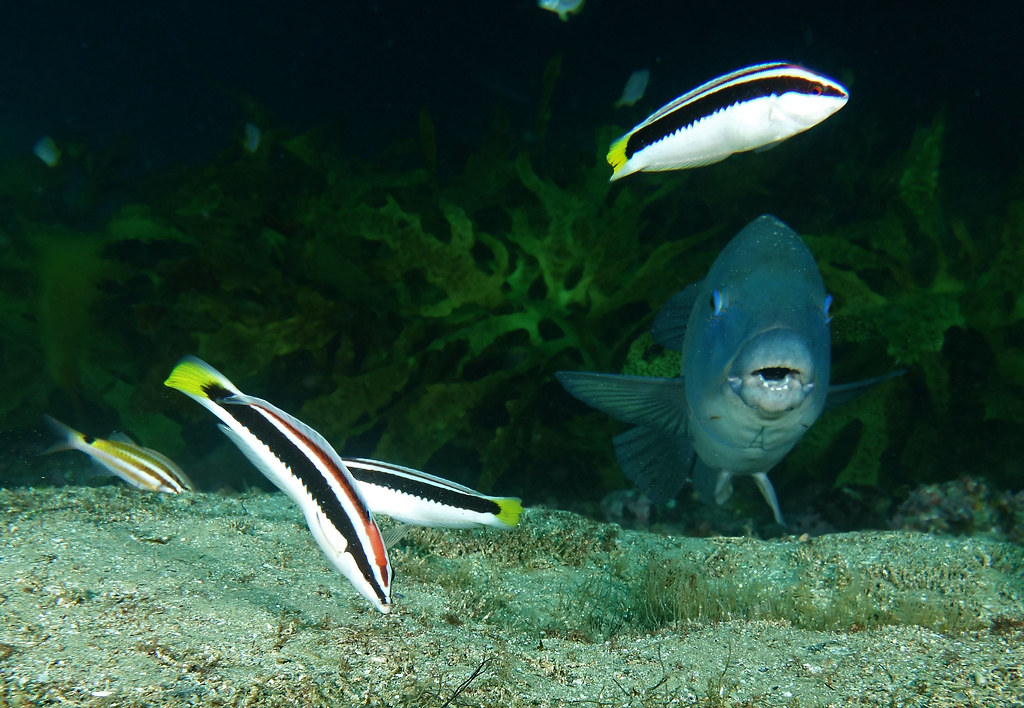
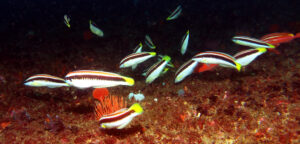
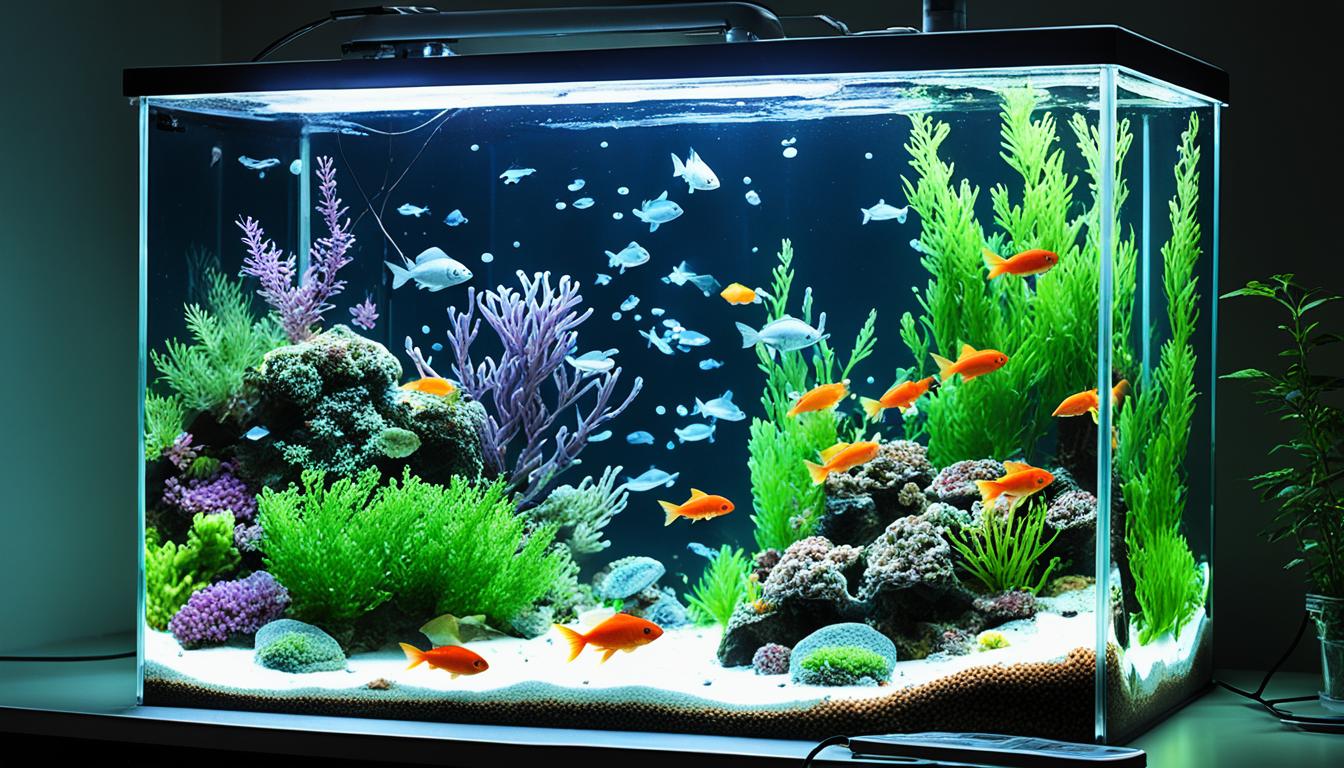
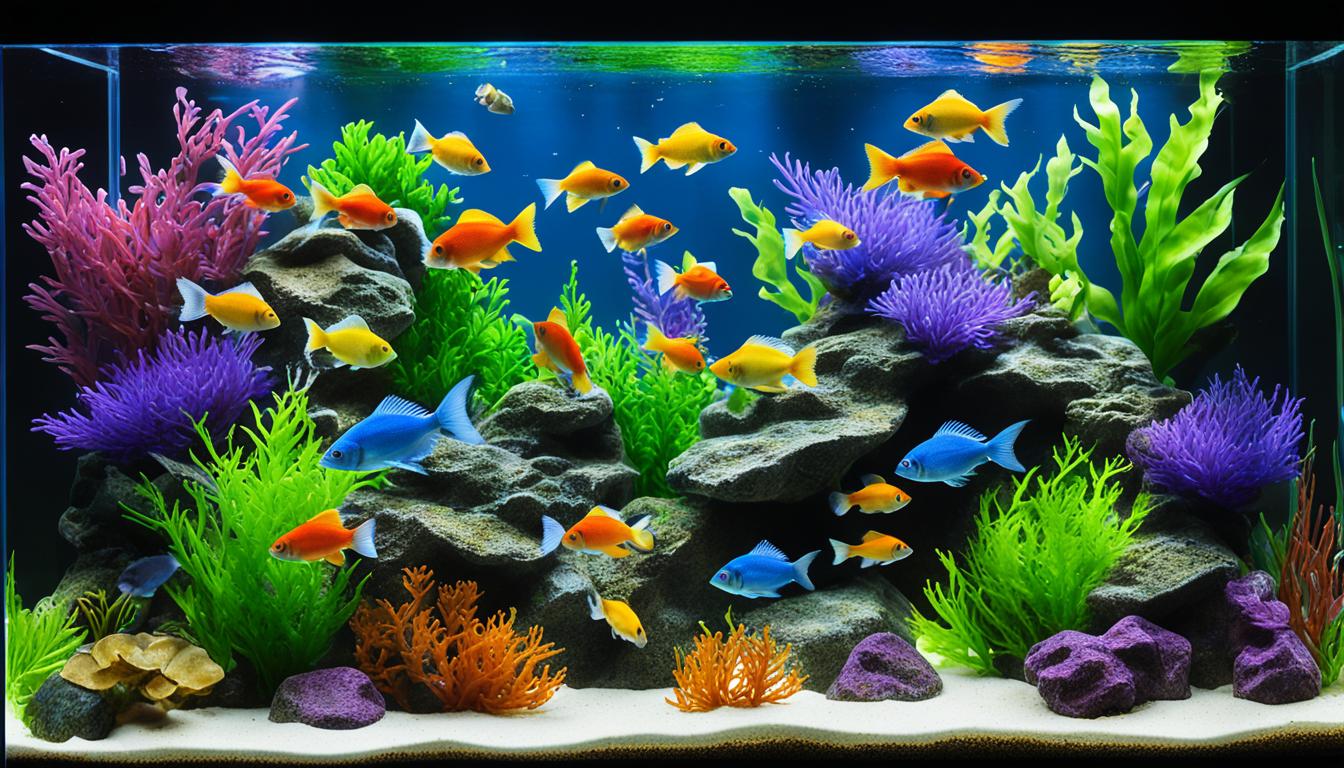






[…] is a popular choice for saltwater aquariums due to its vibrant […]